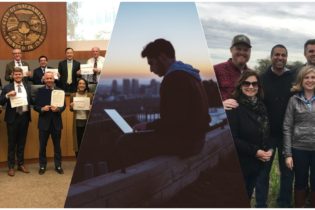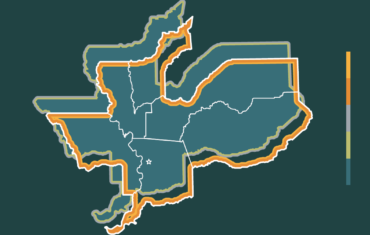Getting Connected in the Capital Region: A Roundtable on Accelerating Broadband Infrastructure Investments

Accelerating broadband infrastructure investment has never been more urgent. Ubiquitous broadband is indispensable to our region’s recovery and resilience in the wake of the COVID-19 pandemic.
On Thursday, October 1, Valley Vision, the California Emerging Technology Fund (CETF), and the Sacramento Area Council of Governments (SACOG) virtually co-convened broadband partners and stakeholders to discuss how to accelerate broadband infrastructure investments across the region. The event also launched highlights of “Getting Connected,” a resource guide for local and regional government leaders to deploy 21st century broadband infrastructure. As manager of the CPUC-funded Connected Capital Area Broadband Consortium (CCABC), Valley Vision partnered with CETF on preparing this leading-edge resource guide, which features best practices, policies, and innovative models to accelerate broadband infrastructure investment and adoption.
Trish Kelly (Managing Director for Valley Vision) and Sunne McPeak (President and CEO of CETF) began the event with welcome remarks. They provided an overview of the CCABC mission; the Greater Sacramento Region Prosperity Strategy’s broadband infrastructure, access, and adoption priorities; Valley Vision and CETF’s Preferred Scenarios work identifying unserved communities, available public assets, and funding needs; as well as major new opportunities in the broadband space, following the Governor’s Executive Order N-73-20 for the California Broadband Council to create the California Broadband for All Plan by the end of the year.
Dr. David Espinoza (Valley Vision’s Project Lead for Innovation and Infrastructure) emphasized the need for increased investment in broadband. Espinoza did a deep dive into new data he generated estimating the cost of filling broadband gaps in the CCABC Region to achieve the State’s goal of 98% broadband service connectivity for households. The presentation featured coverage maps at different speed thresholds, and the methodology to calculate the cost per household for technologies such as fiber-to-the-home and fixed wireless in different geography and terrain scenarios.
Next, Isa Avanceña (Project Associate at Valley Vision), presented an overview of the Resource Guide. The Guide includes an overview of select broadband plans and ordinances across the State; case studies for broadband deployment and adoption; and a list of additional resources from national and state broadband agencies and organizations. It covers crucial topics such as broadband master plans, Dig Once/”Dig Smart” policies, municipal fiber to the premises, master license agreements, and 5G. The Resource Guide is being finalized, and will be released and widely disseminated in November.
The event also brought together regional internet service providers and local elected officials in a two-part roundtable. Espinoza facilitated a roundtable discussion with a panel of Internet service and broadband infrastructure providers that included Crown Castle, Digital Path, GeoLinks, Zayo, and T-Mobile. In their discussion, the panelists identified what they need from jurisdictions in order to reduce the barriers to broadband infrastructure and deployment, as well as some of the best practices that they’ve come across currently being implemented in some cities and counties. Kelly facilitated a roundtable discussion with a panel of local elected officials: Mayor Pro Tempore Tom Stallard of the City of Woodland, Supervisor Don Nottoli of Sacramento County, and Supervisor Gary Bradford of Yuba County. They highlighted some of the challenges they face in getting fast and reliable internet access to all communities in their jurisdictions, and the solutions that they’d like to pursue to move the needle on the issue.
The event generated a lot of momentum to accelerate partnerships and investments across the Capital Region, with collaboration and communication being two actions identified by all as essential to economic recovery and progress. Valley Vision thanks CETF for its continued support of our mission, and thanks all who participated; we look forward to advancing timely and effective solutions with our partners across the region.
Event materials are available on the Valley Vision website, and provide more detailed information on the subject matter and outcomes:
This blog focuses on just some of the updates at the state, county, and local level. To continue staying up to date with all of the region’s broadband efforts, subscribe to Valley Vision’s e-Connect email newsletter!





